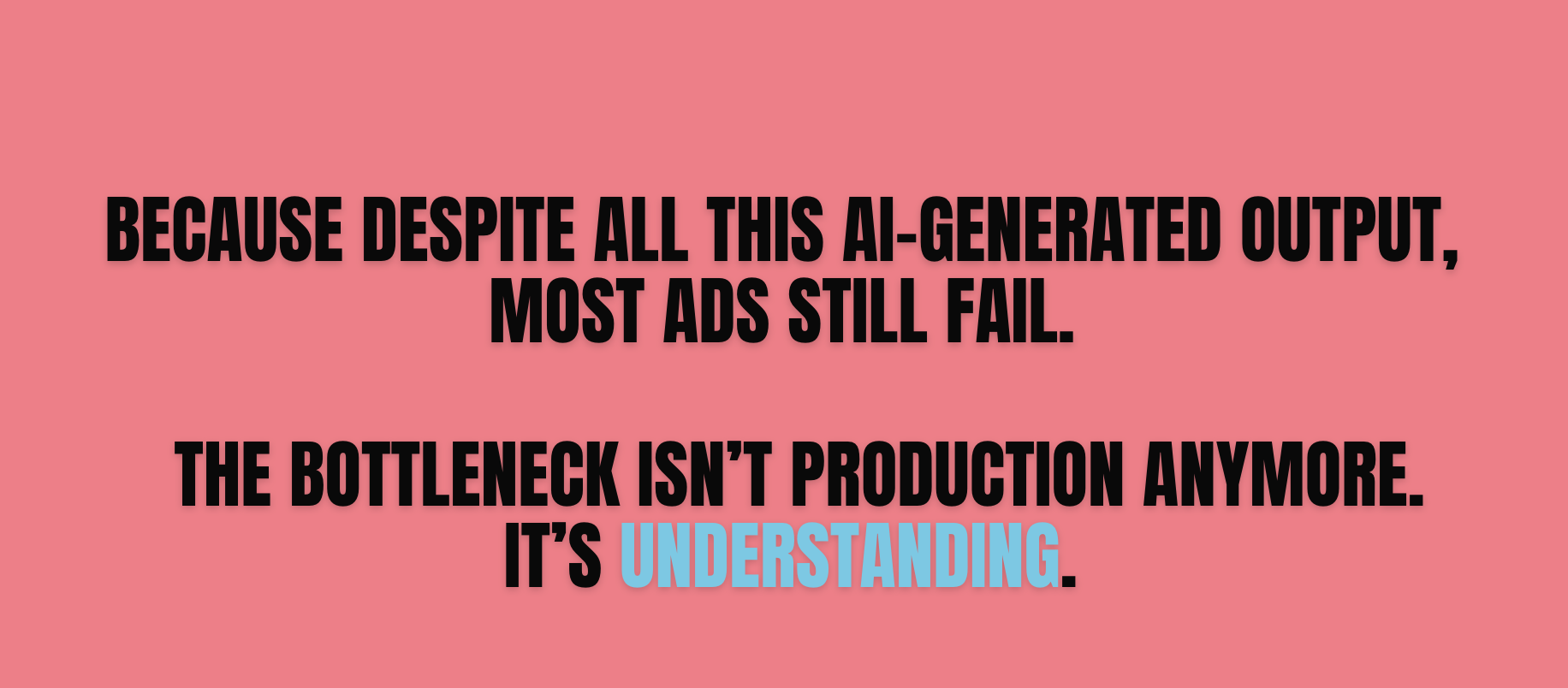
For the last few years, the marketing industry has been obsessed with speed. How fast can we generate new assets? How quickly can we test another variation?
How many ads can we produce before the next product drop? Artificial Intelligence supercharged this mindset. Suddenly, we could generate hundreds of creatives in minutes. endless variations, instant copy, voiceovers, motion, translations, captions. But here’s the uncomfortable truth: more ads does not mean better ads.

We now live in an era where everyone can create. From indie founders to global brands, AI has democratized production. But with abundance comes noise. The real challenge isn’t making ads anymore, it’s knowing what matters. The question creative strategists, CMOs, and performance marketers now face is simple but critical:
“If everything can be created, how do we decide what actually works?” Because despite all this AI-generated output, most ads still fail. Benchmarks across platforms show that 90–95% of ads underperform, burn budget, and never reach scale. The bottleneck isn’t production anymore - it’s understanding.
At Upspring.ai, we believe AI’s job isn’t to replace human creativity, it’s to refine it. AI should not be the new production line. It should be the creative strategist’s microscope. When built right, AI becomes the bridge between:
Instead of churning out endless variations, AI should help us:
That’s the future we’re building toward: one where AI brings clarity, not chaos.
Too many “AI marketing” solutions focus on output, not outcome. They help you generate faster, not think smarter. The result? Teams buried in more versions, more files, more dashboards… and less direction.
The irony is that AI has made marketing faster but more blind. We’ve traded craftsmanship for convenience. We’ve automated production but not judgment.
That’s why creative teams still wake up to the same questions: What should we make next? The answers exist - hidden inside performance data, ad libraries, and human behavior signals. But until now, those insights have been fragmented, slow, and reactive. AI can change that. If it’s trained not just to generate, but to understand.
Creative Intelligence, the layer Upspring.ai is pioneering, does something fundamentally different. It doesn’t just create or tag ads.It analyzes, predicts, and explains creative performance. We built an AI pipeline that ingests billions of ads across brands, industries, and years of creative evolution and surfaces why certain creative patterns win.
It can identify:
It’s AI that thinks like a strategist, not a generator.
In most marketing organizations, creative and performance teams meet weekly to ask the same question: “What’s working and what’s not?” Those meetings are full of guesses, screenshots, and subjective opinions. Upspring changes that dynamic. It creates a shared source of truth that both teams can see - one that explains performance through creative variables. For creative teams, it’s clarity. For performance teams, it’s control.
When AI bridges those languages, emotion and metrics, collaboration becomes seamless. Instead of “your ad didn’t work,” it becomes: “This concept works 3x better when the product is visible in the first 2 seconds.” That’s Creative Intelligence in action.
The difference between generic AI and Upspring’s AI is what it’s trained to do. Most tools optimize for copy length or color palette. Upspring’s AI learns from the strategic layer - what stories, emotions, and formats historically drive performance in your category.
We call this Performance Continuity - a system that connects creative signals before launch to performance outcomes after launch.
Instead of post-mortems, you get pre-flight intelligence. Before your ad ever runs, our AI can:
The result: fewer wasted cycles, faster learning, and higher creative hit rates. Let’s be clear: the best ads in the world will always come from humans. AI doesn’t feel emotion, it recognizes patterns of emotion. It doesn’t dream, but it can show you what types of dreams have worked before.
When used right, AI becomes a creative co-pilot:
That’s how AI helps creative teams stay bold and smart.
Marketers spend millions trying to answer one question: Why did this work?
Until now, that answer lived buried inside ad dashboards, analytics tools, and opinions. Upspring’s mission is to bring it to the surface, to give every brand, agency, and creative team the ability to see what’s working and why. Because once you know that, you can scale with intent. And when creative and performance teams share that same rhythm insights flow faster, decisions are clearer, and performance becomes predictable.
That’s not just efficiency. That’s transformation. Every technological leap in marketing has come with the same promise: “It’ll make your work easier.” But the truth is, marketers don’t need easier - they need smarter. We don’t need more dashboards - we need direction. We don’t need more AI tools - we need AI that understands creative impact. We don’t need more ads - we need better ads. The future belongs to teams who treat AI as a creative partner, not a shortcut. To those who use it to elevate craft, not automate it. To those who want fewer opinions and more evidence.
At Upspring, our agenda is simple: To help brands scale what’s working. To bring creative and performance teams together under one shared language. To give AI a new purpose, one that’s rooted in human creativity, not automation.
Because the future of marketing won’t be won by who produces the most. It’ll be won by who understands the fastest. And that’s what Upspring is here to deliver.
Written by Yishai Dvash, Co-founder and CMO

001
What is Creative Intelligence
002
What is Upspring.ai’s partnership with Meta?
003
How does Creative Intelligence improve workflow efficiency?
004
How is Upspring different from creative management tools like Motion or Foreplay?
005
How does Upspring.ai help agencies win more clients and scale creative performance?
006
How can brands use Upspring.ai to scale what works?